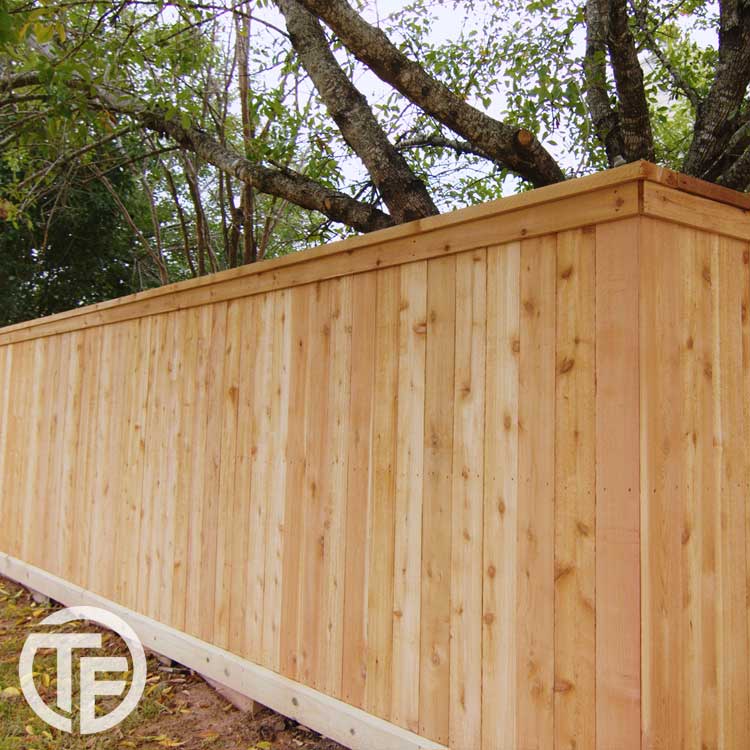How to Care for Your Western Red Cedar Fence: A Comprehensive Guide
Did you know that taking care of your Western Red Cedar fence is like nurturing a fine Texan wine? It requires the right touch, timely attention, and an understanding of its unique qualities to ensure it ages with elegance and strength. In this comprehensive guide, we’re diving deep into the world of fence maintenance. We’ll show you exactly how to make sure your Western Red Cedar fence not only maintains its charming aesthetic appeal, but also stands robust in the face of Texas’ wildest weather. So buckle up, because we’re about to take you on a journey to mastering fence longevity that will save you time and money down the line.

Identifying Fence Damage
Your Western Red Cedar fence is an investment that adds both value and aesthetic appeal to your property. However, like any structure exposed to the elements, it can incur damage over time. Identifying fence damage, whether it be from moisture, insects or other sources, is essential in taking prompt action prevent costly and extensive repairs.
Signs of Moisture Damage
Moisture is one of the biggest threats to wood fences, particularly in wet environments. It’s important to regularly inspect your fence for signs of moisture damage, such as mold or mildew growth or warping boards. Check for loose knots, cracks and splits in the wood as well since these areas are more prone to absorbing excess water.
Termite Damage
As common pests that eat away at wood structures, termites can wreak havoc on a Western Red Cedar fence. If you notice small holes or tunnels within your fence posts, boards or rails, it may indicate termite damage. Termites can weaken and destroy the structural integrity of your fence making it susceptible to further damage.
Natural Wear and Tear
Fences endure substantial wear and tear from exposure to elements such as rain, wind, hail, excessive sun, extreme cold temperatures extending through winter months and so forth. As a result of this wear and tear over time, it is quite normal for natural decay to occur that could potentially lead to splintering boards or dry rot. While not always a cause for alarm, if left ignored or unaddressed these issues can turn into much bigger problems.
Like Maintaining Your Car
Just as you maintain your car with regular tune-ups and oil changes, regularly inspecting and fixing any common fence problems will help prolong the life span of your Western Red Cedar fence while saving you money in expensive repairs long-term.
Now that we have identified some common fence damage, let’s take a closer look at Termite Damage and Loose Boards.
Termite Damage and Loose Boards
Termite infestations in Western Red Cedar fences are a common problem for homeowners in humid and damp locales. Termites can cause structural damage, create warping in wood, or even weaken the fence to the point of collapse.
Warning Signs of Termite Infestations
The first step to identifying and treating termite damage is to know how to spot signs of an infestation. Look out for small holes or tunnels within your fence posts, boards, or rails – termites create these tunnels while eating their way through the wood. Another sign of termite activity is swarming termites, which are winged termites that fly around on warm days looking for new nesting areas.
Treating Termite Damage
If you suspect that your fence has been affected by termites, it’s essential to treat the problem as soon as possible. Treatments such as fumigation and chemical sprays can be effective in eradicating the issue and preventing further deterioration of the Fence. If significant damage has already occurred, it may be necessary to replace some or all segments of your cedar fence.
DIY Solutions
While it may be tempting to attempt DIY solutions when dealing with termite damage or loose boards, it is generally recommended to hire a professional fencing contractor. They have access to advanced treatments not available for consumer purchase and bring experience repairing and restoring damaged fences.
Like a Dental Check-Up
Just like going for a regular dental check-up, periodic inspections by an expert are crucial to ensuring the longevity of your beautiful Western Red Cedar fence’s lifespan. Ask for best practices on prevention from your fencing contractor to avoid costly repairs.
The next section will concentrate on cleaning your Western Red Cedar fence.
- Termite infestations in Western Red Cedar fences are a common problem for homeowners in humid and damp locales, causing structural damage or collapse. Look out for small holes, tunnels, or swarming termites to spot termite activity. It’s essential to treat the problem as soon as possible through fumigation or chemical sprays and by hiring a professional fencing contractor. Regular inspections are crucial to ensure the longevity of your beautiful Western Red Cedar fence.
Signs of Moisture Damage
One of the biggest threats to your Western Red Cedar fence is moisture. This can come from various sources such as rain, humidity, sprinklers, or snow. As a natural wood material, cedar is more susceptible to damage caused by moisture compared to other fencing materials. To protect your fence and ensure it lasts for years to come, it’s important to look out for signs of moisture damage.
One of the most obvious signs of moisture damage is rotting wood. If you see any areas on your fence that are soft to the touch or appear significantly darker than the rest of the wood, it’s likely that there is rot. You should also look out for signs of mold or mildew growth as this indicates excess moisture in the area. In some cases, you may even see fungus growing on your fence which can cause structural damage over time.
Moisture damage can also cause your fence boards to warp or bend. When wood absorbs too much moisture, it expands and contracts which can cause the boards to twist or buckle. This not only looks unsightly but can also weaken the structure of your fence and make it less effective at keeping pets or children inside your property.
Think about a sponge that has been left out in the open for too long after soaking up water. It becomes heavy and difficult to handle, with an unpleasant musty odor. Similarly, when cedar fencing absorbs excessive moisture, it becomes vulnerable to fungus infestation which leads to rotting and distortion.
It’s important not to confuse natural warping with extreme bending and twisting caused by high humidity levels or excess water exposure. Sometimes natural weatherization can create visible cracks without affecting the quality of cedar railings and paneling. However, if you want to preserve cedar’s aesthetic qualities and prolong its lifespan then regular care and maintenance are necessary.
Now that you know what to look for when it comes to signs of moisture damage, it’s time to talk about how to prevent it from happening in the first place.
Cleaning Your Western Red Cedar Fence
Keeping your Western Red Cedar fence clean is an essential part of maintaining its overall condition and appearance. Dirt, debris, pollution, and other outdoor elements can accumulate on the surface of the wood and cause discoloration or staining. Regular cleaning will also help identify any potential damage early on, making it easier to repair before it becomes a bigger problem.
Start by removing any loose debris from your fence using a soft-bristled brush or broom. This could include anything from leaves and twigs to cobwebs or bird droppings. Next, use a garden hose with a low-pressure nozzle attachment to rinse off dirt and grime from the surface of your fence. Be sure to use cold water as hot water can cause the wood to expand which may lead to rotting.
For more stubborn stains and dirt buildup, you may need to use a cleaning solution. There are many commercial cleaning products available that are safe for cedar fencing, or alternatively, you could make your own cleaning solution using natural ingredients such as vinegar, baking soda, or lemon juice. Be sure to follow all instructions carefully and test a small area first before applying any solution to your entire fence.
Some people might argue that power washing is the most effective way of cleaning a wooden fence. While it’s true that pressure washing can remove dirt and grime quickly, it can also damage the wood if not used correctly. High-pressure water can gouge out softer woods like cedar causing them to weaken over time. If you do opt for pressure washing, make sure the intensity is set at just the right level so as not to cause damage.
Pressure washing is like getting a laser-beam treatment for a skin condition when a milder cleansing product would have sufficed. It may be quick and effective, but it can also cause unforeseen damage. As the saying goes: prevention is better than cure. To care for cedar fencing apply preventive measures when maintaining it.
Once you’ve finished cleaning your cedar fence, you might want to consider adding an additional layer of protection to help keep it looking new for longer. In the next section, we will discuss the benefits of sealing and staining your Western Red Cedar fence.
Removing Dirt and Debris
One of the most important aspects of caring for your Western Red Cedar fence is cleaning it regularly. Over time, dirt and debris can accumulate on your fence, making it look dirty and dingy. Not only is this unsightly, but it can also contribute to damage, especially if moisture becomes trapped beneath the debris.
Imagine if you neglected cleaning your car for years, and let the dirt pile up. Eventually, that accumulated grime would start to create issues in its mechanical systems. Similarly, neglecting your Western Red Cedar fence’s cleanliness could result in premature decay and rot.
To get started with cleaning your fence, begin by removing larger debris like leaves and branches manually. This will make it easier to see any remaining dirt or stains. Next, use a broom or brush with stiff bristles to scrub away dirt and debris from the surface of the fence.
To effectively remove stubborn dirt and grime build-up from your Western Red Cedar fence, consider using a pressure washer. Choose a pressure setting appropriate for wood (around 1500 psi), as too much pressure can damage the wood fibers. You should also use a fan tip nozzle when spraying water over the surface of the fence, as this will help prevent concentrated pressure that can scar or mark the wood.
Some homeowners may prefer not to use a power washer because it can be difficult to control how much pressure is applied. Inexperienced users might accidentally strip off layers of wood grain during a single wash cycle which could cause irreparable damage to the deck’s outer layering or lead to an uneven finish after staining or sealing.
Instead of using a power washer, some homeowners recommend making a solution made out of dish soap, white vinegar, and warm water in equal parts then applying this mixture onto the surface with a sprayer or sponge before rinsing it off with water. Though safe and affordable, this method can take more time to accomplish compared to using a power washer.
After you’ve removed debris and dirt from the surface of the fence, consider applying a wood brightener to revive the natural beauty of the wood.
Protecting Your Fence from Future Damage
Once your Western Red Cedar fence is clean and free from debris, it’s time to start thinking about how to protect it from future damage. The number one enemy of Wood fences is moisture. Moisture can seep into fissures in the wood’s exterior, cause rotting, warping, and even breakage if left unchecked. Prevent moisture-related issues by sealing your fence with specific products designed for outdoor use.
Think about sealing your fence like you would apply sunscreen on yourself before venturing out into the sun for a day-long hike — just like sunscreen blocks harmful UV rays from penetrating deep into your skin and causing damage, sealant stops harmful elements like moisture from penetrating deep into the grain of the wood.
There are many types of sealants available for use on Western Red Cedar fences. One option is clear or semi-transparent sealants that offer minimal protection against UV rays while highlighting the natural beauty of cedar grain. Alternatively, there are pigmented sealants that add color and additional protection against moisture. Either way, sealing your Cedar fence will help protect it from harsh weather conditions and staining agents like rust or mildew.
To achieve maximum protection against moisture-related issues with wood fences, consider pairing sealing treatments with regular staining treatments as well – Western Red Cedar is particularly susceptible to fading due to prolonged exposure to sunlight. Stain treatment for wooden fences with cedar-specific qualities helps maintain your fencing investment by preserving its structural integrity without deteriorating prematurely.
On the other hand, some people argue that sealing their western red cedar fence is not advisable since it can trap moisture and oxygen inside, leading to the formation of mildew or mold. They believe that leaving the wood naturally unfinished allows free airflow between the fibers so that they dry out faster.
However, sealants can indeed help slow down further decaying processes caused by moisture build-up since treating wooden fencing with sealing products also inhibits fungal growth to develop in damp wood conditions.
Remember that caring for your Western Red Cedar fence will not only make it look beautiful but will also extend its lifespan. Keep in mind the importance of cleaning it regularly, protecting it from future damage, and preserving its natural aesthetics with staining treatments.
Sealing and Staining Techniques
One of the best ways to protect your Western Red Cedar fence from the elements is to seal or stain it. Cedar is naturally resistant to decay and insects, but regular sealing will help keep it looking new and preserve its beauty for years to come.
When choosing a sealant or stain, there are many options available on the market. Some homeowners prefer a clear sealant that allows the natural color of the cedar to show through, while others prefer a semi-transparent or solid stain that adds color to their fence. It is important to choose a product that is specifically designed for use on cedar wood.
When applying the sealant or stain, always start by cleaning the surface of your fence thoroughly to remove any dirt or debris. If there are any visible signs of mold or mildew, be sure to treat those areas with a bleach and water solution before applying any sealant or stain.
Next, apply the sealant or stain evenly with a brush or sprayer, making sure to cover all surfaces including the ends of each board. It is important not to over-apply the product as this can cause buildup and lead to an uneven finish.
Some homeowners may wonder if they should seal their fence at all since cedar is already resistant to decay and insects. While it is true that cedar has natural oils and acids that help protect it, sealing or staining your fence will greatly extend its life, maintain its composition, and keep it looking new for years.
Think of it like protecting your skin from sun damage. You could go without sunscreen and still technically be okay, but over time you would see damage like wrinkles and sunspots. However, if you use sunscreen regularly, even though your skin already has some built-in protection mechanisms like melanin, you will greatly reduce your risk of damage over time.
Now that we’ve covered sealing and staining techniques, let’s move on to another important aspect of your cedar fence: aesthetics.
Aesthetics of Your Cedar Fence
Your Western Red Cedar fence is not only functional but also an important part of your home’s curb appeal. Choosing the right stain color and finish can add beauty and value to your property, while the wrong choice could leave you with regret.
When deciding on a stain color, consider the style and architecture of your home, as well as any colors that are already present in your exterior decor. It is important to choose a color that complements or contrasts nicely with these existing elements.
Additionally, consider how much maintenance you are willing to put into your fence. A natural clear sealant will allow the wood’s natural beauty to show through but will need to be reapplied every year or two. Solid stains may require less maintenance, as they are more durable than clear sealants; however, they do not allow the natural grain and texture of the cedar to show through.
Some homeowners may wonder if they should go with a stain at all since cedar is already beautiful on its own. While this is true, adding a stain can help protect your fence from the elements and extend its life.
Think of it like adding mascara or lipstick. You don’t need makeup to be beautiful, but a little can enhance what you already have and make you feel even more confident.
Choosing the Right Stain Color for Your Home
One of the best ways to protect and prolong the lifespan of your Western Red Cedar fence is by staining it. Aside from its protective benefits, a stain can also enhance the natural beauty of your fence and complement the overall look of your home exterior.
When choosing a stain color for your fence, there are several things to consider. First, think about the existing colors on your property. The stain color should blend well with the rest of your outdoor decor. If you have a neutral-colored home exterior, a natural wood or light brown stain would be a great option. On the other hand, if you have bold colors on your home, you could choose a darker stain for contrast.
For instance, if you have brick accents on your home exterior, choosing a dark brown or black stain for your fence can help highlight those features and tie everything together. But if you have a lot of greenery in your yard, such as shrubs or trees, a natural wood or light brown stain can complement those organic hues.
Another thing to keep in mind when selecting a stain color is the style and architecture of your home. If you have a modern-style home, you might opt for a darker grey or black stain to match its sleek look. A rustic-style home would pair well with a more natural wood tone.
It’s kind of like picking out an outfit – you want everything to coordinate well and reflect your personal style. Your fence is like the accessory that ties everything together!
If you’re stuck between two or more colors, consider testing them out first before committing to one. Buy small sample sizes of each color and apply them to an inconspicuous area of your fence to see what they’ll look like in different lighting conditions throughout the day.
Additionally, keep in mind that some stain colors will fade faster than others. Lighter stains tend to show wear and tear more easily, so they may need to be reapplied more often. Darker stains may hide some imperfections, but they also absorb more heat from the sun, which can cause them to fade or peel over time.
Some homeowners prefer a weathered look for their fence, in which case no stain would be necessary. While this can certainly work for some people and properties, keep in mind that an untreated fence is more susceptible to rot, decay, and insect damage.
Ultimately, the right stain color for your Western Red Cedar fence depends on your personal style and the existing colors and architecture of your home. By taking these factors into consideration and doing a little testing beforehand, you can ensure that you’re protecting your fence while enhancing its natural beauty.








